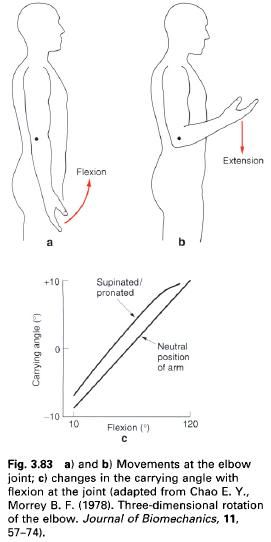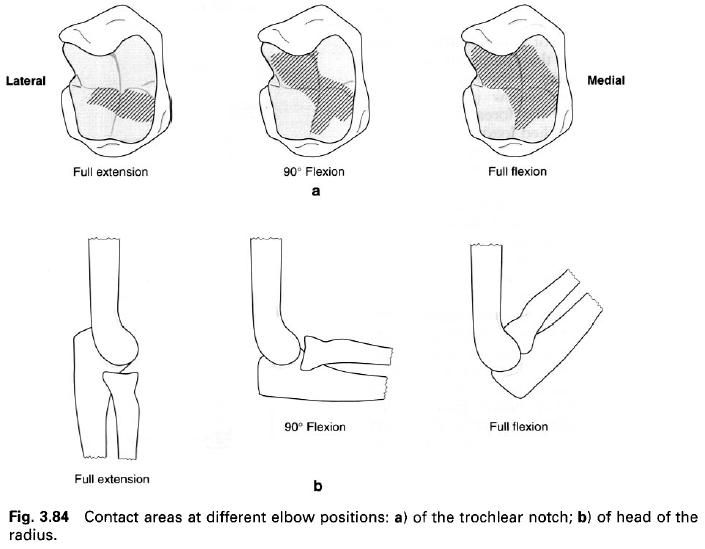PART I
PART II
PART II
Movements
The movements possible at the elbow joint are
flexion and extension, which take place about a transverse axis through the
humeral epicondyles. This axis is not at right angles to the long axis of the humerus or of the forearm, as it bisects
the carrying angle at the elbow. Consequently, its medial end is slightly lower
than the lateral. Except at the extremes of flexion and extension, movement
between the humerus and the radius and ulna is one of sliding. It is only at the extremes, when the axis
of movement changes slightly, that the sliding motion changes to one of rolling
between the articular surfaces. The collateral ligaments are tense in all
positions of the joint.
Flexion and extension
Flexion is movement of the forearm
anteriorly(a). It continues until contact between the forearm and arm prevents
further movement. The active range of flexion is 145°; passively 160° of
flexion can be attained. Because of the obliquity of the axis about which
flexion occurs, the hand moves medially to come to lie over the shoulder.
Flexion is brought about by brachialis,biceps brachii and brachioradialis. In slow gentle movements, brachialis is tha main muscle used,
whereas rapid and forceful movements will use all three muscles as well as the
superficial forearm flexors arising from the medial epicondyle. Flexion is
primarily limited by opposition of the anterior muscles of the arm and forearm,
with tension in the posterior part of the capsule and triceps; the impact of bony surfaces is insignificant.
Extension is movement of the forearm
posteriorly, and is best defined as returning the forearm to the anatomical
position(b). Strictly speaking the range of extension possible at the joint is
zero since full extension corresponds to the anatomical position. However,
relative extension is always possible from any position of the joint. Active
extension is brought about by triceps and
anconeus, while passive extension is due to gravity controlled by the
eccentric contraction of the elbow flexors, particularly when a weight is being
lowered. Extension is usually limited by tension in the anterior joint capsule
and flexor muscles, and to some extent in the anterior parts of the collateral
ligaments.
Limitation of movement, either flexion or
extension, is rarely due to bony contact, although the presence of small
cartilage covered facets at the bottom of the coronoid fossa and at the sides
of the olecranon fossa in some individuals suggests that bony contact occurs
during life.
Because the axis of flexion – extension bisects
the carrying angle it is only to be expected that there is a linear change in
the carrying angle during flexion of the elbow. This occurs irrespective of
whether the forearm is fully pronated or supinated or in some mid-position(c).
The small changes in the position of the axis of movement at the extremes of
the range result in a small degree of axial rotation, which is due to the
configuration of the ulnohumeral articulation and ligamentous constraints.
During initial flexion, the forearm may medially rotate up to 5°, and may
laterally rotate up to 5° during terminal flexion. Although not much, the
movement nevertheless occurs.
Abduction and adduction
Being a hinge joint the only movements expected
at the elbow have already been described. However, during pronation and
supination of the forearm there is a small degree of abduction and adduction
respectively, between the trochlear notch of the ulna and the trochlea of the humerus.
Accessory movements
With the elbow almost fully extended a small
degree of abduction and adduction at the joint is possible. This can best be
demonstrated with the subject lying supine. Holding the lower part of the arm
steady and applying alternate medial and lateral pressure to the lower end of
the forearm will produce these accessory movements.
Biomechanics
Contact
areas
Because of the rounded ridge extending from the
tip of the olecranon to the tip of the coronoid process, and the transverse
ridge observable on the articular cartilage, the trochlear notch can be
conveniently divided into four quadrants(a). Direct observation has revealed
that the contact area on the humerus
changes during flexion and extension. In general, the ulnohumeral contact area
increases from full extension to full flexion, and the head of the radius establishes more and more contact
with the capitulum. The increasing area of contact supports the view that the
stability at the joint increases with flexion. As far as the radius is concerned, it means that it
must move proximally during flexion.
In full extension the contact areas of the
elbow are in the lower part of the trochlear notch, with concentrations on the
medial aspects(a); there is no contact between the radius and capitulum. At 90° flexion, the contact area is a
diagonal strip running from the lower medial to the upper lateral compartment.
Small parts of the superior surface of the coronoid process and of the inferior
surface of the olecranon also show contact. There is some contact between the
capitulum and the head of the radius(b).
It is only when the elbow is fully flexed that a definite area of contact
between the radius and capitulum can
be identified. Trochlear notch contact areas, although of a similar diagonal
orientation, are larger and extend into the upper medial quadrant.
This general increase in contact areas across
the joint serves to reduce the pressure applied to the cartilage, and so help
protect it, particularly when loading is being supported with the elbow flexed,
or when fine manipulative movements are being performed in which many muscles
crossing the joint may be active.
Muscular action and its efficiency
As a group, the flexor muscles are more
powerful than the extensors. Consequently, with the arm hanging loosely by the
side, the elbow tends to be slightly flexed. Not only does the power of the
muscle groups vary with the position of the shoulder, because of the attachment
of biceps and triceps to the supra- and infraglenoid tubercles respectively, but
for the flexors the degree of rotation of the forearm is also an important
factor. As far as rotation is concerned, the power of the flexors is greater
when the forearm is pronated, because biceps
is stretched thereby increasing the efficiency of its action. The flexor
efficiency ratio of the biceps for
pronation and supination is of the order of 5:3.
Biceps works most efficiently between 80° and 90°, brachialis between 90° and 100°, and brachioradialis between 100° and 110°.
Consequently as a whole, the flexor muscles work at their best advantage when
the elbow is flexed at 90°. In this position the muscles are at their optimal
lengths and their direction of pull(line of action), particularly for biceps and brachialis, is almost at 90°
to the forearm. Most of the force of contraction is thus directed towards moving
the forearm and not to the maintenance of the integrity of the elbow joint. The
reverse is true when the elbow is extended, because in this situation the
direction of pull is nearly parallel to the forearm, rather than perpendicular
to it. Because the attachment of the flexor muscles, between the fulcrum(elbow
joint) and the resistance(weight of the forearm and hand together with any
applied loads), conforms to that of a third class lever, it follows that the
flexors favour range and speed of movement at the expense of power.
The extensor muscle triceps is most efficient when the elbow is flexed to between 20°
and 30°. As flexion increases, the tendon of triceps becomes wound around the superior surface of the olecranon,
which thus acts as a pulley. At the same time the muscle fibers become passive
stretched. Both of these features help to compensate for the loss of efficiency
of the muscular flexion. Triceps is
more powerful when the shoulder is flexed, and also when both the elbow and
shoulder are being extended simultaneously from a flexed position, for example
when executing a karate chop. On the other hand triceps is weakest when the elbow is extended at the same time as
the shoulder is being flexed.
There are, therefore, preferential positions of
the upper limb in which the muscle groups achieve maximum efficiency. For
extension this is with the arm and forearm hanging downwards with an angle of
20° to 30° between them. For flexion it is with the arm and forearm stretched
above the shoulder. Thus the muscles of the upper limb have retained their
adaptation for climbing, developed in the dawn of human evolution.











0 коментара:
Постави коментар